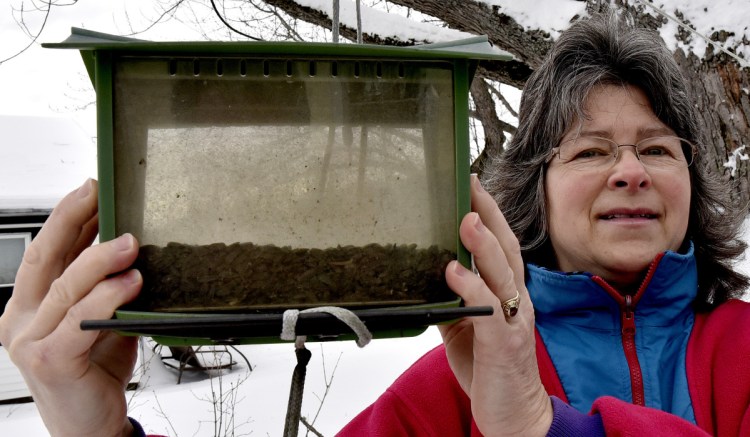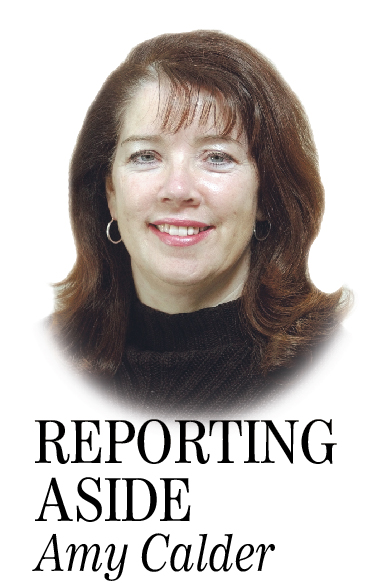Cathy McFarland said she has never seen anything like it in her entire life.
The wild birds she has been feeding at a feeder on her front lawn in Skowhegan every day for more than a half-century just suddenly stopped coming.
It started in mid-September and continued into the winter. While she sees a bird here or there, they don’t flock to her feeder as they always did.
“Normally they would come very regularly and as it gets colder, more regularly,” she said.
McFarland, 57, would get chickadees, tufted titmice, goldfinches, nuthatches, woodpeckers, blue jays, mourning doves, juncos and an occasional cardinal at her feeder.
The sudden disappearance last fall and this winter was shocking and kind of scary, she said.
“I just thought the birds were going away, and I’ve never seen anything like this in my entire life — ever. It was saddening because the birds make me happy, and a little piece of my happiness was taken away from me because I didn’t have the birds to look forward to every day.”
McFarland is one of several people who have told me a similar story — that the birds have flown the coop the last few months. So I decided to investigate.
I got in touch with bird expert Herb Wilson, who assured me the birds have not flown away, never to return.
“There is no need to worry about the bird population,” said Wilson, a Colby College biology professor who writes a biweekly birding column for the Maine Sunday Telegram.
“The results from the recent Christmas Bird Counts indicate that there has been no decline in our resident birds,” Wilson told me in an email. “Birds are finding much of the food they need in the wild.”
He said people always are asking him where the birds are, as they have been absent from their feeding stations this winter, and that absence started in the fall of last year.
Wilson writes a blog, “Maine Birds,” and his blog from Nov. 26, 2017, titled “Where Are the Birds?” answers a lot of questions people have about why they are not seeing as many birds at their feeders.
“The abandonment of bird feeders does not indicate a precipitous decline in bird populations,” Wilson writes in the blog. “The phenomenon of resident birds forsaking our handouts actually occurs every fall. This year’s pattern is, however, one of the most striking ones in my memory.”
Wilson says that while, prior to November, many summer birds moved to warmer climates for the winter, most of the birds that frequent local feeders are “resident birds.”
He said people have noticed the lack of birds, including black-capped chickadees, tufted titmice, white-breasted nuthatches, American goldfinches, downy woodpeckers and hairy woodpeckers; but birds eat from a variety of sources, not just from feeders.
“Birds wander throughout a foraging area to feed from many sources,” his blog says. “The reason for this behavior is basically uncertainty. Any given food source can be depleted in short order. To spread the risk, birds do not depend on a single source of food.”
Birds forage as a group, as that way they are better able to find patches of food and can ward off predators such as hawks, according to Wilson. Last fall, they fed on a lot of natural food, which they prefer to food people leave in their feeders, such as sunflower seeds, he says.
“If your feeding station falls within a winter territory, it is possible that the flock has not even discovered it yet,” he writes. “A possible contributing factor to the lack of feeder birds is a phenomenon called partial migration. Depending on food resources, some but not all members of a resident species may move southward. Blue jays and American goldfinches are perhaps the best known partial migrants, but even chickadees will sometimes stage winter migrations.”
For bird lovers wondering when the birds will return to their feeders, the answer is not definitive, according to Wilson:
“The quick answer is the birds will come back when natural food is depleted, but I don’t know of anyone who has actually measured the amount of seeds and berries this winter,” Wilson tells me. “People also need to realize this winter is not a good year for many species that sometimes move south for the winter into Maine. These birds included red-breasted nuthatch, common redpoll, pine siskin, purple finch, pine grosbeak, evening grosbeak and white-winged crossbill. Those birds haven’t been pushed south by the lack of food to our north as happens in some years when our feeders are overrun. I once had over 500 Common Redpolls at my feeder one winter.”
In addition to consulting with Wilson, I called University of Maine’s Somerset County Cooperative Extension in Skowhegan to ask if officials there have had inquiries about lack of birds at feeders the last few months.
Gail Watson, administrative specialist and coordinator of the senior companion program, said the office has received calls from people reporting the lack of birds at feeders in the area.
Watson, who lives in Cambridge, where she has table bird feeders and walks a lot in the woods and rural areas, said she saw many birds in the woods in the fall, where there was plentiful food and a wide variety, including seeds and berries. She said she was not concerned about the birds not frequenting her feeders because she knew they had food sources in the woods.
“They have started coming in the past two to three weeks,” Watson said. “I have a vast variety of birds — mourning doves, jays, juncos, goldfinches, nuthatches.”
After relaying Wilson’s explanation about the birds to McFarland in Skowhegan, she was much relieved and declared she would spread the word among her bird-lover friends who have been worried about their absence.
Wilson’s prediction about the return of the birds serves as balm to McFarland’s fears.
“As long as I know they’re going to come back,” she said. “I hope they never go away again, because it’s so sad. The birds are a big part of my happiness.”
Amy Calder has been a Morning Sentinel reporter 30 years. Her column appears here Mondays. She may be reached at acalder@centralmaine.com. For previous Reporting Aside columns, go to centralmaine.com.
Send questions/comments to the editors.



